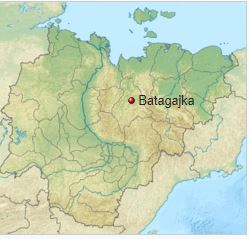
Melting permafrost, which some attribute to climate changes, is creating huge craters in Siberia. The craters are appearing as layers of ice melt, and large holes in the tundra sink downward as if they were elevators moving down the shaft, foot by foot. National Geographic has described the phenomenon as a “doorway to hell.”
Siberia is peppered with these craters, called “thermokarst depressions,” but one, in particular, is being watched with great interest. Batagaika Crater, found near the village of Batagai in the Verkhoyansk district, was created after the deforestation of an area near the town took place in the 1960s.
When the area flooded in 2008, the sinking land portion became larger. The ravine began to sink more and more and has reached the rate of almost 50 feet per year. In fact, layers of soil from about 200,000 years ago have been exposed around the half-mile perimeter of the 320-foot-deep hole. If a regulation-sized American football field could be tipped up at the short end, it would fit in nicely–and it is still sinking.
As the crater grows larger, more land is swallowed up, and a nearby valley is in danger of being completely destroyed. Researchers call these craters a “climate time bomb.”

Batagajka
Permafrost is found in areas of average temperature just below freezing. It is overlain either by solid ice or, as is the case with the Siberian tundra, by an active layer of organic material that seasonally freezes and thaws. When the underlying soil, sediment, or rock has been frozen for two or more consecutive years, it is considered permafrost. Most of the Arctic and Antarctica are permafrost areas, and much of northern Siberia is tundra covered with small shrubs, moss, and bog plants that grow during the summer.

Batagaika crater, August 27, 1999
Nothing permanent can be built on permafrost because of the changing nature of the ice. Recent climate changes are reportedly the cause of melting permafrost, causing sea levels to gradually rise. More layers of the ice are being exposed, bringing with them organic materials that release carbon dioxide and methane gases as they decay. Those gases in turn increase thawing and melting; it becomes a vicious circle. According to the International Permafrost Assocation, areas that were previously frozen are changing with landslides, erosion, and the disappearance of shallow lakes. Some permafrost is only about a yard deep while other areas can be almost a mile thick.
Buried in the deep permafrost are millions of years of dinosaurs, aquatic life, plant matter, seeds, and animal and human bodies, some in a remarkable state of preservation. Even ancient bacteria have been discovered. The Yukagir Bison, found in Russia in 2011, was in an unusually well-preserved condition, looking as if it had just laid down to sleep. This applies as well to the two 10,000-year-old cave lion cubs found in Siberia in 2015. These cubs still had their skin and fur, as the collapse of the cave that killed them also preserved their bodies. Their mother’s milk was found still in one of the week old cubs’ stomachs.

Batagaika crater, August 20, 2005
This year, the body of a woman who died 900 years ago was found in the far north of Siberia near Salekhard, on the edge of the Arctic Circle. According to Siberian Times, the 12th century woman was “a member of an unknown hunting and fishing civilization that held sway in Siberia–with surprising links to Persia.” She has eyelashes visible as well as a full head of hair and teeth, “buried in a cocoon of copper and fur.” A series of tests will be conducted on her remains in order to learn more.

Batagaika crater, July 23, 2013
The exposed layers of earth’s history have drawn many geologists to this part of the world, and they have recovered remains of mammoths, bison, horses, wolves, and reindeer. When it comes to the craters, the layers tell the stories of previous climate disruptions throughout the centuries, the remains of what was once an ancient forest of spruce and pine, and even ancient pollen. Samples have been taken and distributed around laboratories in several countries to be dated and studied, and the research results were published in February 2017 in Cambridge’s Quaternary Research.
Photos of the changes between 1999 and 2013 at NASA’s website also show the progression of the size of the crater.
